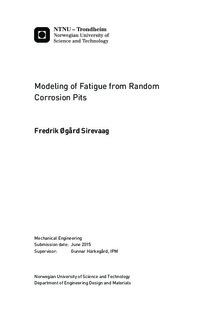| dc.contributor.advisor | Härkegård, Gunnar | |
| dc.contributor.author | Sirevaag, Fredrik Øgård | |
| dc.date.accessioned | 2015-10-05T14:53:18Z | |
| dc.date.available | 2015-10-05T14:53:18Z | |
| dc.date.created | 2015-06-09 | |
| dc.date.issued | 2015 | |
| dc.identifier | ntnudaim:13451 | |
| dc.identifier.uri | http://hdl.handle.net/11250/2350233 | |
| dc.description.abstract | This master thesis is a continuation of the project work Fatigue Assessment of Mechanical Components with Random Surface Defects written during the fall of 2015. Central tasks of this report has been to create a manual calculation method for the case of corrosion pitting fatigue to verify the LINKpfat FEM post-processor. Simple components subjected to corrosion pits and alternating loading have been used to validate the Random Defect module of LINKpfat. This module allows the user to define an area on a 3D component from Abaqus that will be attacked by surface defects. These defects can be defined to be randomly allocated on the surface, and their size and number can be controlled by several probability distributions. It is assumed that the corrosion pits were already established on the components and would not grow further from the corrosive environment.
A literature review was made to find the necessary data to test LINKpfat against fatigue test results. While there are many papers published on the subject it was very difficult to find all the necessary inputs well defined. Corrosion pit shape is also dependent on the material and corrosive environment. Only one fatigue test had all input parameters readily available and was used as a test on how well the software could predict cycles to failure with realistic corrosion properties. Some simplifications had to be made on the 3D component due to a weakness in LINKpfat s geometric calculation method.
Results from the fatigue test was good, considering all the variable input parameters that play a role in determining the cycles to failure. For the crack growth curve that gave the best results, LINKpfat returned conservative results that estimated roughly half the fatigue life compared to the test data. Most of the critical pits found in the software were within the expected variance due to the probabilistic distribution properties. A few statistical outliers were generated and their results seem unrealistic when compared to the average values found. This is most likely caused by some oddity in the way the generated defects are calculated when finding the critical one for each component. More validation work needs to be performed on the software side to determine why these results occur on rare occasions. | |
| dc.language | eng | |
| dc.publisher | NTNU | |
| dc.subject | Produktutvikling og produksjon, Materialer | |
| dc.title | Modeling of Fatigue from Random Corrosion Pits | |
| dc.type | Master thesis | |
| dc.source.pagenumber | 95 | |

